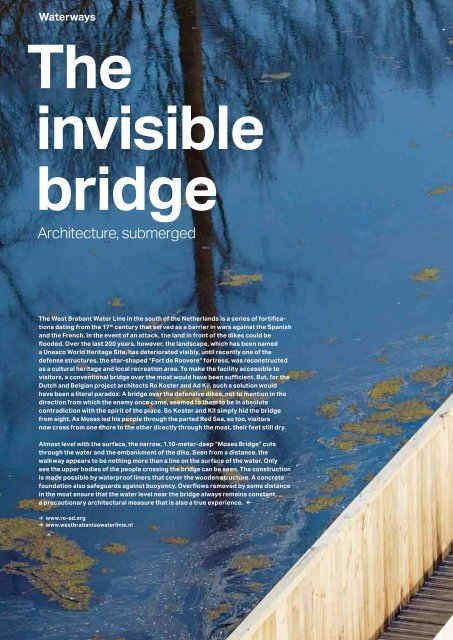Geberit View 2012
Geberit View 2012
Geberit View 2012
You also want an ePaper? Increase the reach of your titles
YUMPU automatically turns print PDFs into web optimized ePapers that Google loves.
Waterways<br />
The<br />
invisible<br />
bridge<br />
Architecture, submerged<br />
The West Brabant Water Line in the south of the Netherlands is a series of fortifications<br />
dating from the 17 th century that served as a barrier in wars against the Spanish<br />
and the French. In the event of an attack, the land in front of the dikes could be<br />
flooded. Over the last 200 years, however, the landscape, which has been named<br />
a Unesco World Heritage Site, has deteriorated visibly, until recently one of the<br />
defense structures, the star-shaped “Fort de Roovere” fortress, was reconstructed<br />
as a cultural heritage and local recreation area. To make the facility accessible to<br />
visitors, a conventional bridge over the moat would have been sufficient. But, for the<br />
Dutch and Belgian project architects Ro Koster and Ad Kil, such a solution would<br />
have been a literal paradox: A bridge over the defensive dikes, not to mention in the<br />
direction from which the enemy once came, seemed to them to be in absolute<br />
contradiction with the spirit of the place. So Koster and Kil simply hid the bridge<br />
from sight. As Moses led his people through the parted Red Sea, so too, visitors<br />
now cross from one shore to the other directly through the moat, their feet still dry.<br />
Almost level with the surface, the narrow, 1.10-meter-deep “Moses Bridge” cuts<br />
through the water and the embankment of the dike. Seen from a distance, the<br />
walkway appears to be nothing more than a line on the surface of the water. Only<br />
see the upper bodies of the people crossing the bridge can be seen. The construction<br />
is made possible by waterproof liners that cover the wooden structure. A concrete<br />
foundation also safeguards against buoyancy. Overflows removed by some distance<br />
in the moat ensure that the water level near the bridge always remains constant,<br />
a precautionary architectural measure that is also a true experience. ←<br />
→ www.ro-ad.org<br />
→ www.westbrabantsewaterlinie.nl





